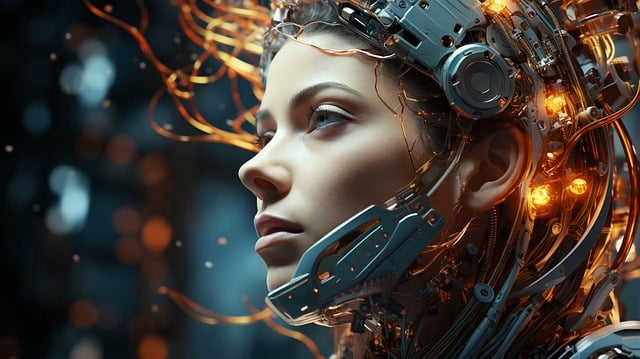
The world of technology has taken a leap forward with the rise of neural networks, the backbone of artificial intelligence. These complex systems replicate the functions of the human brain to learn and make decisions autonomously, making it possible for machines to recognize patterns, classify information, and even predict outcomes.
Neural networks have revolutionized industries such as finance, healthcare, and transportation, where data analysis and interpretation is critical. For instance, in the financial industry, neural networks are used for fraud detection and stock market predictions. Healthcare providers rely on these networks for disease diagnosis and treatment planning. Meanwhile, self-driving cars are becoming a reality because of the power of neural networks to identify driving patterns and make decisions accordingly.
The potential of these networks is unlimited, and it is only a matter of time before we see more exciting developments. With a never-ending stream of data and algorithms, these networks are becoming more sophisticated, allowing for faster and more accurate results.
However, some people still view neural networks with suspicion, fearing that machines might replace human intelligence. It’s a legitimate concern, but the truth is, advanced technologies like neural networks have the potential to empower humans, amplifying our intelligence and solving problems beyond our reach.
Perceptrons and Artificial Neurons in Neural Networks
Artificial neurons, often referred to as perceptrons, are the foundational building blocks of neural networks. Let’s delve into the essential concepts of perceptrons and artificial neurons, which serve as the basis for more complex neural network architectures.
The Perceptron Model
The perceptron is a simplified model of a biological neuron, designed to process information and make decisions. It plays a vital role in understanding the core principles of neural networks.
- Neural Activation: Similar to a biological neuron, a perceptron receives input signals, processes them, and produces an output.
- Weights and Activation Function: Perceptrons assign weights to input signals, and the weighted sum passes through an activation function, determining the neuron’s output.
- Thresholding: The output is binary, typically 0 or 1, based on whether the weighted sum exceeds a defined threshold.
Activation Functions
Activation functions are crucial elements in neural networks that introduce non-linearity into the model. They play a pivotal role in enabling neural networks to approximate complex, non-linear relationships in data.
- Step Function: The simplest activation function, known as the step function, mimics the binary output of a perceptron.
- Sigmoid Function: The sigmoid function produces a smooth S-shaped curve, allowing for the modeling of probabilistic outcomes and smooth transitions between values.
- Hyperbolic Tangent (tanh): Similar to the sigmoid function, the hyperbolic tangent function provides non-linearity and maps input values to the range [-1, 1].
- Rectified Linear Unit (ReLU): The ReLU activation function is widely used in modern neural networks. It introduces non-linearity by returning the input for positive values and zero for negative values.

Understanding perceptrons and activation functions is essential for grasping the fundamental principles of neural networks. These basic components serve as the basis for more complex neural network architectures, enabling the processing of increasingly complex data and the development of deep learning models.
Feedforward Neural Networks (FNN)
Feedforward Neural Networks (FNN), also known as multilayer perceptrons, represent a fundamental architecture in the realm of neural networks. Let’s explore the core concepts and workings of FNNs, which are essential for understanding the broader landscape of neural network models.
Architecture and Layers
FNNs are characterized by their layered structure, consisting of input, hidden, and output layers. This architectural design is integral to their ability to process and transform data.
- Input Layer: The input layer serves as the entry point for data. It receives raw features or information, and each neuron in this layer represents a specific feature.
- Hidden Layers: Hidden layers, which can vary in number, are responsible for learning complex patterns and representations from the input data. These layers introduce non-linearity and play a crucial role in the network’s ability to model intricate relationships.
- Output Layer: The output layer produces the final results or predictions. The number of neurons in this layer depends on the nature of the task, such as classification, regression, or other specific objectives.
Forward Propagation
FNNs use a process called forward propagation to transform input data into meaningful output. This process involves passing data through the network’s layers, where each neuron performs weighted summation and activation.
- Weighted Summation: In the forward pass, each neuron in a layer computes a weighted sum of the values from the previous layer, applying a set of weights associated with each connection.
- Activation Functions: Activation functions, such as ReLU, sigmoid, or tanh, introduce non-linearity by mapping the weighted sum to an output within a defined range. Activation functions enable FNNs to capture complex patterns and relationships in data.
- Output Generation: The output layer produces the final results or predictions based on the activations of the neurons in the hidden layers.
Training Neural Networks
Training neural networks is a critical aspect of their use in artificial intelligence and machine learning applications.
Backpropagation Algorithm
Backpropagation is a key algorithm used to train the networks by iteratively adjusting the network’s weights to minimize the error or loss function. This process is integral to the network’s ability to learn and make accurate predictions.

Forward and Backward Pass: Backpropagation operates in two phases. The forward pass involves making predictions on the input data, and the backward pass computes the gradients of the loss with respect to the network’s weights.
Gradient Descent: The gradients computed during the backward pass guide the optimization process. Gradient descent algorithms, such as stochastic gradient descent (SGD) or Adam, are commonly used to update the weights in the direction that minimizes the loss.
Loss Functions
Loss functions, also known as cost functions, measure the error between the network’s predictions and the ground truth. The choice of a suitable loss function depends on the specific task the neural network is designed for.
Mean Squared Error (MSE): MSE is often used for regression tasks, where the goal is to predict continuous values. It measures the average squared difference between predicted and actual values.
Cross-Entropy Loss: Cross-entropy loss is employed for classification tasks. It quantifies the dissimilarity between predicted class probabilities and the true class labels.
Optimization Techniques
Various optimization techniques are utilized to enhance the training process and help the networks converge faster and more effectively.
- Learning Rate Scheduling: Adjusting the learning rate during training can improve convergence. Techniques like learning rate annealing or adaptive learning rates, as in Adam, help control the step size during weight updates.
- Regularization: Techniques such as L1 and L2 regularization, dropout, and early stopping are used to prevent overfitting and improve generalization.
- Batch Normalization: Batch normalization is applied to normalize the input to each layer, accelerating training and improving convergence.

Training neural networks involves a delicate balance of adjusting weights, minimizing loss, and preventing overfitting. This training process is pivotal in the development of powerful machine learning models that can tackle a wide range of real-world problems.
Through backpropagation, the choice of appropriate loss functions, and the use of optimization techniques, these networks learn from data and make increasingly accurate predictions.
Real-World Applications
Neural networks have found widespread use in real-world applications across various domains. Their ability to process complex data, learn patterns, and make intelligent predictions has rtrevolutionized fields such as artificial intelligence, machine learning, and computer science.
Image and Speech Recognition
- Facial Recognition: Neural networks power facial recognition technology, enabling applications in security, unlocking smartphones, and organizing photo libraries.
- Object Detection: Convolutional Neural Networks (CNNs) are used to identify objects in images and videos, making autonomous vehicles, surveillance systems, and augmented reality possible.
- Speech Recognition: Recurrent Neural Networks (RNNs) are employed for speech recognition in virtual assistants like Siri and transcription services.
Natural Language Processing
- Machine Translation: Neural networks, especially sequence-to-sequence models, have significantly improved machine translation, allowing for real-time language translation services.
- Sentiment Analysis: Sentiment analysis applications use these networks to understand and classify sentiment in social media posts, customer reviews, and feedback.
- Chatbots and Virtual Assistants: The technology power chatbots and virtual assistants, offering natural language interaction, customer support, and information retrieval.
Autonomous Systems and Robotics
- Self-Driving Cars: The technology play a pivotal role in enabling autonomous vehicles to perceive their environment, make decisions, and navigate safely.
- Robotic Automation: In manufacturing and logistics, robots are controlled by neural networks to perform tasks like sorting, packing, and assembly.
Healthcare
- Disease Diagnosis: The technology assist in medical image analysis, aiding in the detection of diseases like cancer and other medical conditions from MRI and CT scans.
- Drug Discovery: Neural networks are utilized for drug discovery and design, accelerating the process of identifying potential treatments.
Finance
- Algorithmic Trading: These networks are employed for predicting stock prices and developing trading algorithms that can make real-time investment decisions.
- Fraud Detection: Financial institutions use neural networks to detect fraudulent transactions and safeguard against unauthorized access.
Neural networks have become indispensable tools in solving real-world problems and are at the core of the technological advancements that drive innovation in diverse fields. As they continue to evolve and adapt to new challenges, their applications will expand, further revolutionizing industries and improving our daily lives.
Challenges and Future Trends
Neural networks have made remarkable strides in various fields, but they also face challenges and hold exciting prospects for the future. This section explores the current challenges and emerging trends within the realm of neural networks.

Ethical Concerns and Bias
Neural networks can perpetuate biases present in training data, leading to discriminatory outcomes in areas like facial recognition and hiring processes. The inherent complexity of deep neural networks raises concerns about their transparency and the ability to provide explanations for their decisions.
Explainable AI (XAI)
Researchers are developing neural network architectures that are more interpretable, allowing users to understand why a model makes specific predictions. The future of neural networks includes a focus on ethical AI, ensuring fairness, accountability, and transparency in decision-making processes.
Advancements in Neural Network Architectures
Capsule networks (CapsNets) aim to address the limitations of traditional CNNs in understanding spatial hierarchies and object relationships. Inspired by the human brain, spiking neural networks aim to improve energy efficiency and cognitive capabilities in AI systems. The intersection of quantum computing and neural networks holds the potential to revolutionize machine learning by solving complex problems more efficiently.
Transfer Learning and Few-Shot Learning
Neural networks are increasingly incorporating transfer learning techniques, enabling models to leverage knowledge from one task to improve performance on another. Developing networks that can learn effectively from a limited amount of data remains a challenge and a promising avenue for research.
Hardware Acceleration
Neuromorphic hardware mimics the human brain’s architecture, offering energy-efficient solutions for neural network processing. Custom-designed AI chips are emerging to accelerate neural network computations, enhancing performance and efficiency.
Neural networks are poised to continue their transformation of industries and technologies. As they address ethical concerns, incorporate explainability, and evolve in architecture and hardware support, they will open doors to innovative applications and empower more robust and ethical artificial intelligence systems. The challenges they face are driving research and development, ensuring that the future of neural networks is bright and filled with potential.
